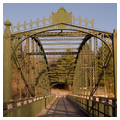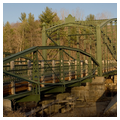The great continental transportation expansion of the nineteenth century created a huge demand for river crossings for canals, railroads, and roads. Inventors scrambled to patent dozens of new bridge types, most of which were popular for only a few years before being supplanted by newer designs. Among these innovations was the parabolic or lenticular truss bridge, first widely used in Germany. In the United States the parabolic truss bridge had two primary promoters. These were William O. Douglas, who obtained patents in 1878 and 1884 for his design, and engineer Charles Jarvis, who obtained Douglas's patents and formed the Berlin Iron Bridge Company, which constructed many Douglas and Jarvis parabolic-truss iron bridges throughout Vermont, including one at the Missisquoi falls in Richford in 1882. Among the few remaining examples in the nation and the only surviving example in the state, this one crosses the Missisquoi River amidst the spume of Highgate Falls. The bridge is formed of two lenticular trusses: a through truss that is two hundred and fifteen feet in length and an approach pony truss eighty feet long. Lenticular trusses were known for their particular elasticity, so that horses traveling at more than a walk would set them bouncing.
Slated for demolition after it was bypassed by the current VT 207 bridge, the structure was mothballed after the Vermont Division of Historic Sites in 1974 nominated it to the National Register of Historic Places. It languished until 1999, when the Vermont Agency of Transportation utilized federal transportation enhancement dollars to restore this civil engineering monument for the use of pedestrians and anglers.










